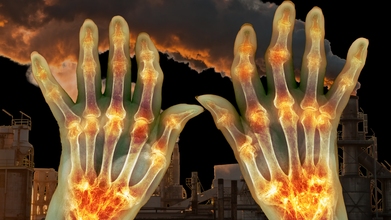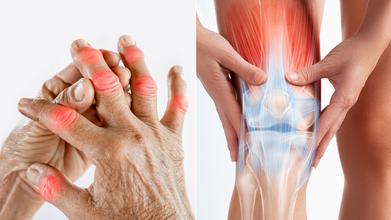- Health Conditions A-Z
- Health & Wellness
- Nutrition
- Fitness
- Health News
- Ayurveda
- Videos
- Medicine A-Z
- Parenting
- Web Stories
World Brain Day 2025: Signs of Brain Tumors You Might Be Dismissing as “Just Stress”

Credits: Canva
Every year, World Brain Day is marked to raise awareness around brain health and neurological conditions that often go undiagnosed or misunderstood. This year’s theme focuses on brain health and early detection, emphasizing how subtle signs—often brushed off as routine stress—may actually be the brain’s way of raising an alarm.
While stress-related fatigue, burnout, and tension headaches are all-too-common in today’s never-resting, always hustling world, experts warn that dismissing persistent or unusual neurological symptoms as “just stress” could delay diagnosis of something more serious, such as a brain tumor.
We spoke with Dr. Mukesh Kumar, Director and Head (Parkinson's Disease Unit), Neurosciences, Neurology, Max Super Speciality Hospital, Saket, to understand the difference between stress symptoms and potential red flags.
Not All Headaches Are Just “Stress Headaches”
Headaches are the most common symptom people link with stress, but not all headaches are created equal.
Dr. Kumar explains, “A worst headache in the morning may be a feature of subarachnoid haemorrhage (SAH), which is a medical emergency. Stress headaches are usually mild to moderate and without vomiting. SAH is usually very severe and comes with nausea or vomiting.”
He adds that if your headache feels significantly different from your usual ones, especially if it’s persistent, worsening over time, or most intense after waking up, it’s worth seeking a neurological opinion.
Brain Fog vs. Brain Tumor-Linked Cognitive Symptoms
Feeling mentally scattered, struggling to focus, or forgetting things easily? It could be burnout, but not always.
“Brain fog due to burnout is usually transient, affecting multiple domains and without any functional disability,” says Dr. Kumar. It’s often tied to sleep issues like delayed sleep initiation or fragmented rest.
On the other hand, “Cognitive disability related to a brain tumor may affect one or more specific cognitive domains, tends to persist, and comes with functional disability,” he adds. You may also notice seizures, limb weakness, or trouble with routine tasks.
Clumsiness and Loss of Balance: When It’s Not Just Fatigue
Occasional clumsiness may seem harmless, especially during hectic workweeks. However, if it progresses to frequent falls, a noticeable decline in coordination, or needing support for routine tasks, don’t ignore it.
Dr. Kumar advises, “See a neurologist if there’s physical disability, frequent falls, need for support in walking, or significant reduction in your day-to-day functional efficiency.”
These may point to disturbances in the brain’s motor control centers, possibly caused by a tumor affecting balance and coordination.
Sudden Mood Swings or Personality Changes? Take Note
Stress does affect mood, but a rapid and unexplained shift in personality could be neurological. “Sudden personality changes, if persistent for a few days to weeks, suggest early features of a brain tumor,” says Dr. Kumar.
So, if someone who’s usually calm becomes irritable, withdrawn, or impulsive with no clear reason—and these changes don’t go away, it’s time for a deeper evaluation.
Vision and Speech Fluctuations
Blurred vision, slurred speech, or trouble finding the right words after a long day might seem like signs of tiredness. But if these symptoms come and go—or worsen—don’t brush them off.
According to Dr. Kumar, watch out for “faster reaction or impulsive behaviour, neck and back pain, early morning back stiffness, fluctuating vision or speech issues, and disturbed sleep patterns.” These are neurological red flags that demand attention.
Listen to Your Brain
The key message this World Brain Day is simple: Don’t ignore what your brain is trying to tell you. While stress is real and widespread, persistent or unusual symptoms—especially if they’re affecting your daily life—deserve a professional checkup.
As Dr. Kumar sums it up, “Early detection can significantly improve outcomes in brain tumors. When in doubt, get it checked out.”
Not Just Respiratory Diseases, Air Pollution Can Also Trigger Rheumatoid Arthritis, According To Doctors

Credits: Canva
Air pollution levels in Delhi rises after the festive celebrations in October, and due to the cold weather, the polluted air looms around us. While all of us are aware of the respiratory illnesses caused by air pollution, a new study has now shown that it could also trigger rheumatoid arthritis.
At the 40th annual conference of the Indian Rheumatology Association (IRACON 2025), which was held at the Yashobhoomi in Dwarka, with leading rheumatologists present there, revealed that there is plenty evidence that shows how toxic air and PM2.5 pollution could fuel a surge in cases of rheumatoid arthritis across Delhi-NCR.
What is rheumatoid arthritis?
It is a chronic autoimmune disease that causes pain, swelling, stiffness, and warmth in the joints and affects mostly small joints of hands and feet in a symmetrical pattern. It occurs when the immune system attacks the body's own tissue, particularly the lining of the joints and leads to inflammation or even damage to cartilage and bones.
What Are The Experts Saying?
The experts have pointed out that autoimmune diseases like rheumatoid arthritis was traditionally linked to genetics and immune system dysfunction. However, now it is increasingly being associated with environmental factors too. One of the biggest trigger is air pollution. As per the current estimates, the condition affects 1% of India's adult, and pollution adds fuel to the fire. The experts suggested with pollution being on the rise, the cases are expected to increase too.
"When pollution levels are high, the patients who do well otherwise, their condition also worsen… We are observing a rise in RA cases in patients living in polluted areas with no family history or genetic predisposition to autoimmune disease,” said Dr Uma Kumar, Head of Rheumatology at AIIMS Delhi. She also pointed out that most of these patients are between the age 20 to 50. “This is a public health emergency we can no longer ignore,” she said.
Dr Pulin Gupta, who is a professor and rheumatologist at the Dr Ram Manohar Lohia Hospital said, “What we are witnessing is not just a increase in cases of RA but these cases are also more severe… Reduced green spaces in urban areas are worsening the problem, depriving residents of protective environmental buffers.”
He also said that studies have now shown a strong association between exposure to PM2.5, nitrogen oxides, and ozone with increased risk of rheumatoid arthritis cases. "Living near busy roads, which means constant traffic-related pollution, has also been linked to higher RA risk,” he said.
What Is The Study Experts Are Basing Their Opinions At?
Dr Gupta pointed out the study that was the base of this claim of the relationship between pollution and rheumatoid arthritis. The 'landmark study' is published in the European Medical Journal, 2025, which has provided strong genetic evidence that connect air pollution to autoimmune diseases, including rheumatoid arthritis.
The study has used two-sample Mendelian randomisation approach and identified significant causal links between common pollutants and immune system dysfunction. It has also highlighted environmental damage as a crucial driver in the rise of these diseases.
Dr Gupta pointed out that Delhi is one of the top 10 most polluted cities in the world and has thus emerged as a hotbed of concern.
“Pollution is rewriting that narrative… turning healthy individuals into patients. The fact that young people with no family history are developing RA should set alarm bells ringing," said Dr Neeraj Jain, Scientific Chairman and Vice Chairman, Department of Rheumatology at Sir Ganga Ram Hospital.
“European cohorts similarly reported that people living in highly polluted cities had significantly higher morbidity related to autoimmune disorders. These findings mirror what doctors are now observing… with Delhi residents facing a double blow of respiratory distress and autoimmune flare-ups,” he said.
Former US President Joe Biden Starts Radiation Therapy To Treat Prostate Cancer

Credits: Canva
Joe Biden, the former president of United States in May announced that he had been diagnosed with prostate cancer and that it has spread to his bones. As per the recent reports, Biden is not undergoing a new phase of treatment for an aggressive form of cancer, confirmed a spokesperson.
The spokesperson of the former president said, "As part of a treatment plan for prostate cancer, President Biden is currently undergoing radiation therapy and hormone treatment."
As per the reports, the radiation treatment is expected to last for five weeks, and it will thus mark a new point in his care. He has already been taking a pill form of hormone medication for his condition.
It was last month only when Biden, 82, started a skin cancer treatment, known as Mohs surgery. What worried people was the large bandage on his forehead, which had been visible in public appearance.
The procedure, however, went well, the physician wrote: "all cancerous tissue was successfully removed" and that "no further treatment is required."
What Happened To President Joe Biden?
The former U.S. president revealed in May that he had been diagnosed with an aggressive form of prostate cancer that had already spread to his bones. His office stated that he was exploring multiple treatment options to manage the illness effectively and maintain his quality of life.
Following his diagnosis, he shared a heartfelt message on X, thanking people for their love and support, and acknowledging that cancer is a disease that touches every family in some way.
Medical experts noted at the time that because the cancer had metastasized, it was likely developing for several years before being detected. Prostate cancer can grow slowly in many cases, but when it reaches advanced stages, it often spreads to nearby tissues or bones, making treatment more complex.
Is Prostate Cancer Common In Men?
Men of his age group are typically not screened regularly for prostate cancer. According to the American Cancer Society, prostate screening is generally recommended every two years for men in their 50s and 60s, depending on risk factors and family history. It remains unclear whether he had undergone prostate cancer screening during his last medical examination while in office.
Now approaching his 83rd birthday, the former president is said to be “doing well” under ongoing medical supervision. His health updates have been closely watched, given his age and public profile.
In 2023, during a routine physical exam, doctors removed a skin lesion from his chest that was later confirmed to be cancerous.
He left the White House in January, just months after suspending his re-election campaign the previous year. In a significant political move, he endorsed Vice President Kamala Harris as his successor, citing his confidence in her leadership.
The final months of his presidency and campaign were marked by debates over his age and fitness for office, criticisms that he and his family consistently dismissed. Despite these challenges, his recent updates suggest a focus on health, family, and recovery, as he continues to receive widespread support from the public.
New Developments Like Lower Doses of Radiation And Drug-filled Cartilage Could Help In Arthritis Treatment

Credits: Canva
Each year on October 12 the world observes Arthritis Day to bring attention to the medication condition and ways to find out to prevent and to treat it as there is no cure. However, apart from the traditional treatments like medication, physical therapy, lifestyle changes, and surgery to manage symptoms, there have ben new treatments in the recent times too. Before jumping into what those treatments are, let us first understand what is arthritis?
It is a medical term for joint pain, inflammation, and stiffness, with over 100 different types. It also includes osteoarthritis and rheumatoid arthritis.
Osteoarthritis: It is a progressive, degenerative joint disease where the protective cartilage cushioning the ends of the bones breaks down. It then causes pain, stiffness, swelling and reduced mobility and affects the hands, knees, hips and spine.
Rheumatoid Arthritis: It is a chronic autoimmune disease that causes pain, swelling, stiffness, and warmth in the joints and affects mostly small joints of hands and feet in a symmetrical pattern. It occurs when the immune system attacks the body's own tissue, particularly the lining of the joints and leads to inflammation or even damage to cartilage and bones.
What Are The New Treatment On Arthritis?
As per the multiple new studies present at the American Society of Radiation Oncology (ASTRO), 2025, researchers from Korea, the US, and Germany reported that mild doses of radiation can significantly reduce pain and also improve mobility in patients with osteoarthritis.
Radiation Therapy For Arthritis
In South Korea, a randomized clinical trial was conducted with 114 volunteers, who had knee arthritis, and were treated with 3 Gy of radiation, which had spread over six sessions. Researchers also noticed that 70% of participants experienced meaningful improvement in pain, function and overall functioning. This was way higher than the 42% improvement seen in the placebo group.
Low-dose radiation is already common in the Europe. However, strong randomized data was limited till now. Dr Byong Hyuck Kim of the Seoul National University, who led the study also emphasized that here, the radiation doses are 10 to 20 times lower than cancer therapy levels and targets only the joints far from the vital organs.
Artificial Cartilage Helps Arthritis
Researchers from the University of Cambridge designed an artificial cartilage that could help with arthritis treatment. This 'cartilage' can sense tiny changes in the body, including arthritis flare-up and release drugs exactly when and where they are needed.
The 'cartilage' is squishy in nature and can be loaded with anti-inflammatory drugs that are released in response to small changes in pH in the body. During arthritis flare-up, joint becomes inflamed and more acidic. The 'cartilage' becomes softer as the change in pH is noticed, especially when the acidity increases and it triggers the release of drug molecules that can be encapsulated within its structure.
The entire study is published in the Journal of American Chemical Society.
© 2024 Bennett, Coleman & Company Limited

